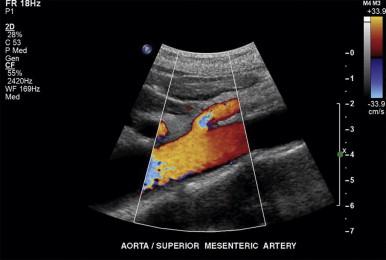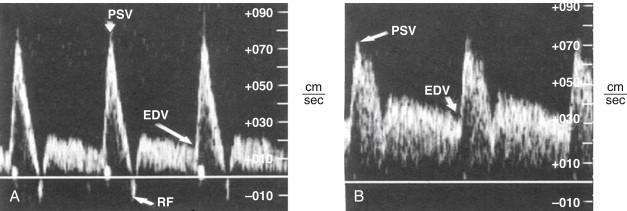Physical Address
304 North Cardinal St.
Dorchester Center, MA 02124
Duplex scanning of the mesenteric vessels is performed to determine the presence, location, extent, and severity of stenosis, aneurysm, or other disease of the mesenteric arteries. It includes assessment of the superior mesenteric artery (SMA), the celiac artery (CA), and the inferior mesenteric artery (IMA). Of these, assessment of the SMA and CA is the most important. The IMA is often difficult to examine, and the IMA is commonly not visualized.
Indications for mesenteric artery duplex imaging include abdominal bruit, aneurysm of the visceral vessels, suspected compression of the CA, and vascular insufficiency of the intestines. Mesenteric duplex scanning can be used to identify stenoses and occlusions of the mesenteric arteries but cannot be used to diagnose intestinal ischemia.
In the 1990s, retrospective studies first investigated duplex evaluation of CA and SMA stenosis followed by prospective studies to test duplex criteria for CA and SMA stenosis. Additional studies have investigated the utility of postprandial duplex scanning as a further means of potentially establishing a diagnosis of chronic intestinal ischemia and possibly determining finer categories of mesenteric artery stenosis. Duplex scanning is useful in diagnosis of celiac access compression and to evaluate mesenteric bypass artery grafts and stents.
To minimize bowel gas interference, mesenteric duplex scanning is best performed early in the day with the patient fasting. The patient is supine, and the head of the bed is elevated to 30 degrees. B-mode imaging and Doppler insonation of the visceral vessels is required. Doppler frequencies are typically in the range of 2.0 to 5.0 MHz. Gray-scale and color-flow imaging ( Figure 1 ) are used to identify and follow the selected vessel segments and to note the presence or absence of any disease process within the vessel lumen. Doppler evaluation quantifies the severity of the disease and should include assessment for the presence or absence of flow and, when flow is present, evaluation of peak systolic velocity (PSV) and end diastolic velocity (EDV). Spectral analysis should be obtained in all vessel segments. Measurements should be obtained proximal, throughout, and distal to any flow disturbance identified. All spectral derived velocity information should be derived with a Doppler insonation angle between 45 and 70 degrees. Angles of insonation exceeding 70 degrees result in significant artificial elevation of velocities.

Fasting SMA and CA waveforms differ. Fasting peak-systolic velocities in the SMA tend to be higher than those in the celiac artery. Fasting end-diastolic velocities also tend to be lower in the SMA than in the CA. Peak systolic velocities in the SMA in angiographically normal vessels vary from 125 to 170 cm/sec. A reverse flow component is often present at the end of systole in the SMA but not in the CA ( Figure 2 ). The increased diastolic flow present in the CA compared to the SMA likely reflects the decreased end organ resistance of the hepatic and splenic circulations versus that of the fasting intestinal circulation.

Become a Clinical Tree membership for Full access and enjoy Unlimited articles
If you are a member. Log in here